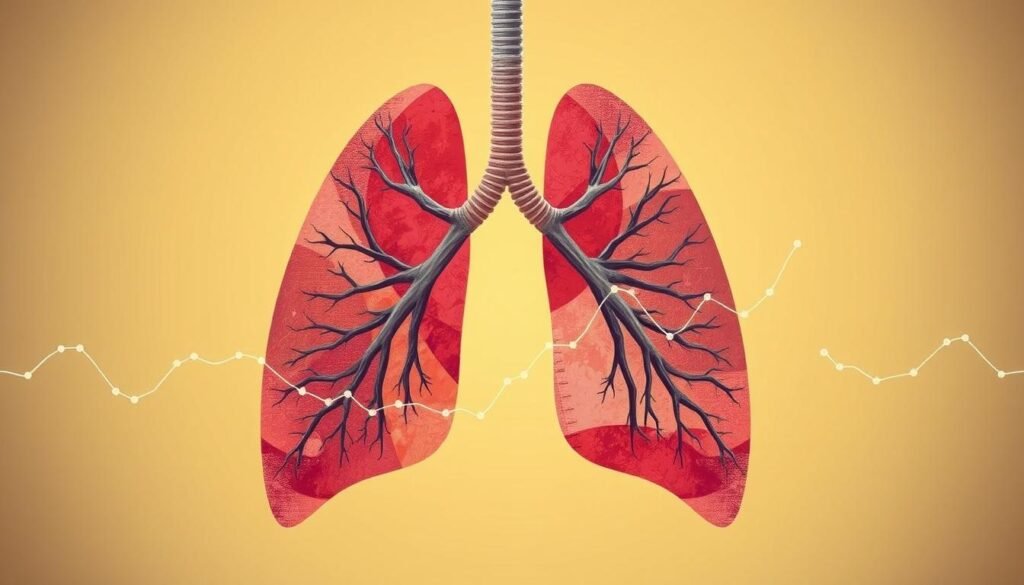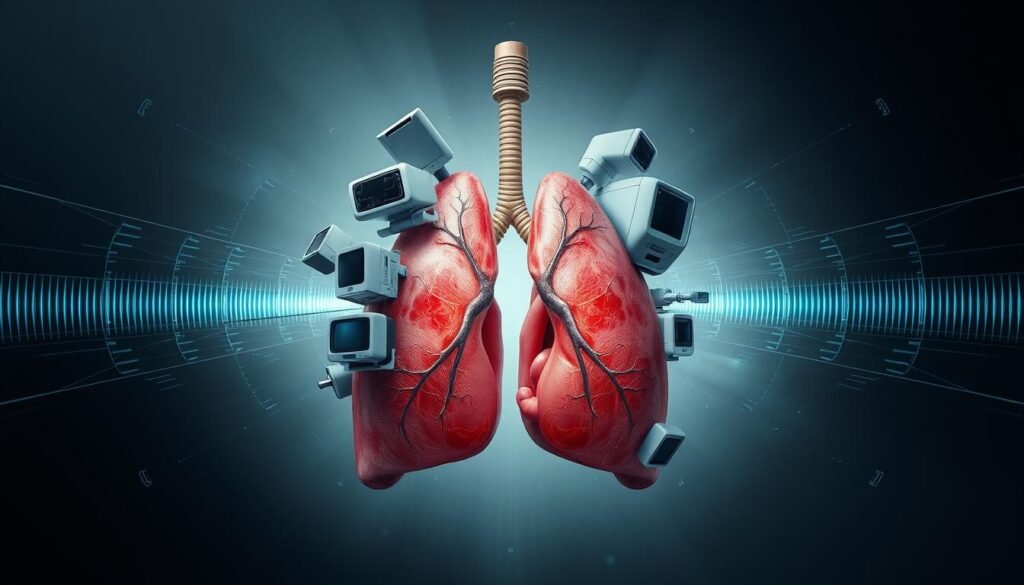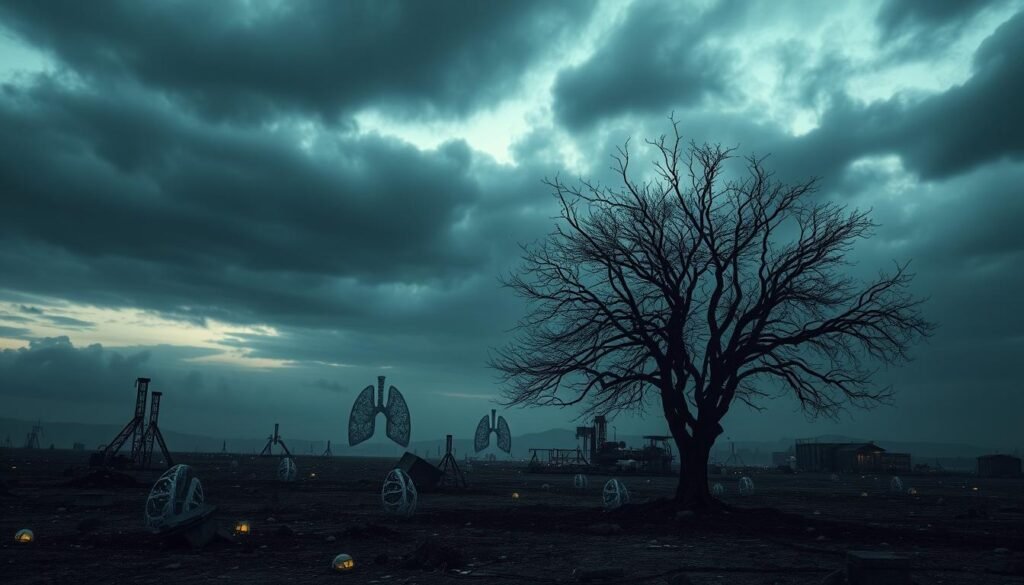About one-fifth of lung cancer cases in people exposed to radiation are linked to World War II atomic bombings. This fact highlights how important it is to understand radiation’s role in lung cancer. Lung cancer is very deadly and not only caused by smoking. Radiation exposure also plays a big role.
Having cancer risk factors, like radiation, doesn’t mean you’ll definitely get lung cancer. But, it does raise your chances significantly.
Studies keep showing us how radiation is connected to lung cancer. Both ionizing and non-ionizing radiation increase cancer risk, especially lung cancer. It’s key to know these connections to lower risks and boost public health knowledge.
Key Takeaways
- Radiation exposure is linked to approximately one-fifth of lung cancer cases related to atomic bombings.
- Women show a greater excess relative risk for lung cancer due to radiation exposure compared to men.
- Cigarette smoking significantly exacerbates the risk of lung cancer, intensifying the impacts of radiation exposure.
- Small cell carcinoma appears to have the strongest association with radiation exposure among lung cancer types.
- Radon gas is a major contributor to lung cancer risk, especially for smokers.
- Occupational hazards further illustrate the diverse sources of radiation exposure linked to lung cancer.
Introduction to Lung Cancer and Risk Factors
Lung cancer leads in causing cancer deaths globally. It’s vital to know the lung cancer risk factors for prevention. Smoking is a big cause, being behind about 90% of cases. The risk increases with more cigarettes smoked and for longer periods. Quitting smoking greatly reduces the risk of this severe disease.
Besides smoking, other factors are also worrying. Radon exposure accounts for about 30% of lung cancer in non-smokers. This gas comes from the natural breakdown of uranium in soil, rock, and water. Workplace dangers, like being around asbestos, arsenic, nickel, and chromium, also raise the risk, especially for smokers.
Air pollution is another risk factor to consider. Polluted air has been linked to lung cancer, making it riskier for some people. Also, having a family history of lung cancer doubles the risk. It’s crucial for those with family cases to be extra careful.
Understanding how these risk factors work together shows the importance of knowledge. It’s a key step in lowering your risk. For detailed info, check out the American Cancer Society.
Understanding Radiation and Its Types
Radiation comes in many forms of energy that move as waves or particles through space. Knowing about it is key since both ionizing and non-ionizing radiation can deeply affect our health. This part explains what radiation is and looks into its various kinds, focusing on their effects on health.
Definition of Radiation
Radiation is energy that comes from a source and can travel through matter. It can show up as electromagnetic waves or particles. Radiation is a big idea since it includes a lot from visible light to gamma rays. Specially, ionizing radiation exposure is risky and can change cells, sometimes leading to cancer.
Types of Radiation: Ionizing vs. Non-Ionizing
Radiation splits into two categories: ionizing radiation and non-ionizing radiation. Both types affect health differently:
- Ionizing Radiation: This kind has gamma rays, X-rays, and high-energy particles that can break electrons off atoms. That can harm DNA and may cause cancer-causing radiation. It’s a big concern in medical treatments and in the environment. Cancer radiation treatment and diagnostic X-rays are examples.
- Non-Ionizing Radiation: This type includes lower-energy waves like radio frequencies, microwaves, and infrared radiation. Usually, it’s seen as less harmful. But, being around some sources for too long should still make us careful.
Knowing the types of radiation helps in health care for prevention and treatment. Each kind has its own risks and benefits. Making good choices about exposure is vital, especially with ionizing radiation exposure.
Radiation as a Risk Factor for Lung Cancer
Understanding how radiation exposure affects lung cancer risk is vital. Research shows that radiation therapy and environmental radiation increase lung cancer chances. This connection is important because it affects many people.
Link Between Radiation Exposure and Lung Cancer Risk
Radiation exposure raises concerns, especially for those who had radiation therapy for other cancers. People who received radiation in the chest area are more likely to get lung cancer, especially smokers. This relationship highlights the need for careful monitoring and preventive actions. Studies suggest that the risk of lung cancer increases over time after radiation therapy.
Types of Radiation Linked to Lung Cancer
Several types of radiation, like ionizing radiation from radon, are linked to lung cancer. Radon, a natural gas, is the top cause of lung cancer in non-smokers. Moreover, air pollution and industrial chemicals also increase cancer risks.
People in jobs like rubber manufacturing are at a higher risk due to radiation exposure. Knowing the types of radiation linked to lung cancer helps in making prevention plans. It’s critical for educating both the public and health workers about radiation dangers.
Radon Gas Inhalation and Lung Cancer
It’s important to know about radon gas, especially because it can cause lung cancer. This gas has no color or smell. It comes from the breakdown of uranium in soil and rock. Radon can build up in homes, putting people at risk. Being around radon for a long time can make lung cancer more likely. This makes it a major issue for those who own homes.
What is Radon and Where Does it Come From?
Radon comes from the earth, created when uranium breaks down. It can enter homes through cracks in floors and walls. If radon isn’t handled, it can reach harmful levels. About 3–14% of lung cancers are linked to radon. This gas is the second main cause of lung cancer for both smokers and non-smokers.
Statistics on Radon Exposure and Lung Cancer Cases
Radon is linked to around 21,000 deaths a year in the U.S. More than 10% of these deaths are non-smokers. This shows how serious radon is for everyone’s health. People who smoke and are also around radon have a much higher risk of lung cancer. The EPA says to take action if radon levels are over 4 picocuries per liter (pCi/L). This high level of radon affects about 1 in 15 American homes.
The table below shows important statistics on radon and lung cancer:
| Statistic | Value |
|---|---|
| Annual Lung Cancer Deaths due to Radon | 15,000 to 22,000 |
| Percentage contribution of Radon to Lung Cancer cases | 12% |
| Percentage of Non-Smokers among Radon-related Deaths | 10% |
| Average Indoor Radon Level in the U.S. | 1.3 pCi/L |
| Recommended Action Level by EPA | 4.0 pCi/L |
Indoor radon levels are a big health concern. Being aware and taking steps to reduce radon can lower the risks. To find out more about radon and its effects, check out this resource on radon exposure.

Occupational Hazards and Lung Cancer Risk
Some jobs increase the risk of lung cancer due to exposure to radiation. Uranium mining is a key example, with workers facing dangerous radiation levels. They come into contact with radioactive materials or breathe in harmful radon gas.
High-Risk Occupations for Radiation Exposure
People in certain jobs are more likely to get cancer from their work environment. Jobs with high risks include:
- Uranium mining
- Construction work involving asbestos
- Manufacturing sectors related to chemicals and metals
- Healthcare roles involving diagnostic imaging
The International Agency for Research on Cancer has listed many substances that cause lung cancer. This highlights the importance of safety in workplaces with these risks.
Case Studies: Uranium Miners and Their Lung Cancer Rates
Uranium miners’ experiences are crucial for understanding how radiation exposure leads to lung cancer. Studies show they have higher lung cancer rates, often due to radon-222 exposure. Compared to the general population, these miners face a greater lung cancer threat.
It’s important to know how job hazards can increase cancer risk. Taking steps to reduce workplace exposure to dangerous substances is key. For more information on lung cancer risks and prevention, visit this resource.
| Occupation | Type of Exposure | Lung Cancer Risk |
|---|---|---|
| Uranium miner | Radon exposure | High |
| Asbestos worker | Asbestos fibers | Increased |
| Chemical manufacturer | Various carcinogenic agents | Moderate to High |
| Radiology technician | Diagnostic imaging radiation | Moderate |
Impact of Diagnostic Radiation Procedures
Diagnostic imaging is vital in today’s healthcare. It helps doctors find and treat various health issues. Methods like X-rays and CT scans are very useful but they expose us to radiation. This causes worries about the risks of getting lung cancer from them.
Common Diagnostic Imaging and Radiation Exposure
CT scans are a major source of radiation among many procedures. They and others like SPECT and PET are behind about 75% of all radiation non-elderly adults get from medical imaging. On average, a person gets about 2.4 millisieverts (mSv) per year from these. That’s close to the 3.6 mSv from natural sources we’re exposed to yearly.
Cardiac imaging tests have seen a big increase and expose patients to 10 to 20 mSv each time. If someone has many of these tests, their radiation dose can reach 16.4 mSv in three years. This is a serious concern for health experts and patients alike.
Long-Term Risks Associated with Frequent Imaging
There’s worry about the cancer risk from a lot of diagnostic imaging. Studies using the linear non-threshold model show that 100-mSv exposure could mean 240 more lung cancer cases per 100,000 people. Even one CT scan boosts lung cancer risk by almost 0.2%. This highlights the importance of being careful with how much we use these tests.
As technology in diagnostic imaging improves, we must balance medical benefits against possible cancer risks. Talking regularly with healthcare providers helps make wise choices about tests. For more info on the risks of diagnostic radiation, see recent studies.

| Procedure | Radiation Exposure (mSv) | Cumulative Risk of Lung Cancer |
|---|---|---|
| Chest X-ray | 0.1 | Minimal |
| CT Scan | 10 | 0.178% increase |
| Cardiac Imaging | 10-20 | Higher cumulative risk |
The Role of Secondhand Smoke in Radiation Exposure
Secondhand smoke is a big factor in lung cancer. It is third on the list of causes for this illness. Being near secondhand smoke is bad for health now and later, especially with other risks like radiation. We will look at how secondhand smoke makes lung cancer risk go up and how it works with radiation.
How Secondhand Smoke Contributes to Lung Cancer Risk
There are over 7,000 chemicals in secondhand smoke. More than 69 of them can cause cancer, including arsenic and benzene. If you’re around secondhand smoke before you turn 25, your chance of getting lung cancer rises. The risk is high for nonsmokers too if they were exposed early. This link is strong even when we take age, gender, and if someone smokes into account.
The Interaction Between Smoking and Radiation Effects
Smoking and radiation together can make lung cancer risk higher. If smokers or ex-smokers were near secondhand smoke before 25, their risk goes up. This shows the extra danger of being around secondhand smoke early and radiation from work or medical treatments.
| Age of Exposure | Current/Ex-Smokers AOR | Nonsmokers AOR |
|---|---|---|
| Before Age 25 | 1.28 | 1.29 |
| After Age 25 | 0.66 | 0.87 |
Being around secondhand smoke at work might be worse for non-small cell lung cancer than at home. Laws in the U.S. and other places are trying to lessen secondhand smoke. This helps lower the risk of cancer linked to it.
Nuclear Accidents and Increased Lung Cancer Risk
Nuclear accidents, like Chernobyl and Fukushima, have spiked radiation exposure, affecting public health. These events show how serious lung cancer risks can become over time. It’s crucial to understand the impact of high radiation on our health.
Historical Context: Major Nuclear Accidents
The Chernobyl disaster in 1986 is a key example. About 600 workers faced high radiation doses directly. Those who got over 6 grays (Gy) suffered from radiation sickness and some died. Cleaup crews also faced danger, with doses linked to leukemia cases.
Following Chernobyl, locals received average radiation doses of 0.01 Gy until 2005. This constant exposure sparked lung cancer worries, especially in kids exposed to radioactive iodine (I-131). This exposure increased thyroid cancer risks. Studies show I-131 exposure leads to greater DNA damage. This raises important questions about nuclear incidents.
Impact on Public Health and Research Findings
The health impact of nuclear accidents is a big worry. Studies saw a clear link between radiation and higher lung cancer rates. The Life Span Study (LSS) tracked 1,803 lung cancer cases from 1958 to 1999 among 105,404 people. There was a strong connection found, with an excess relative risk (ERR) per Gy of 0.81.
| Study | Cases Identified | ERR per Gy | EAR per 10,000 person-year Gy | Percentage Attributable to Radiation |
|---|---|---|---|---|
| Life Span Study (1958-1999) | 1,803 | 0.81 | 7.5 | 7% |
This shows about one-third of lung cancer cases in the study relate to smoking. But, an important 7% linked to radiation. Data also found men to women had a 3.1 lung cancer risk ratio from radiation at age 30 by age 70 in non-smokers.
Research continues to reveal the lasting effects of radiation on lung cancer risks. These findings stress the long-term health effects of nuclear accidents.

Lung Cancer Screening and Prevention Strategies
Lung cancer screening is key to catching the disease early, especially for those at risk. People with a lot of smoking history, family history of lung cancer, or exposure to carcinogens need it most. It can greatly reduce death rates among these groups. It’s important to know how vital screening is for early help and better patient results.
Importance of Regular Screening for At-Risk Groups
Screening for lung cancer is mainly for adults in high-risk groups, such as:
- Individuals aged 50 to 80 with a history of 20 pack-years or more of smoking.
- Those who currently smoke or have quit within the last 15 years.
- Individuals with a family history of lung cancer.
The US Preventive Services Task Force pushes for yearly screening with low-dose computed tomography (LDCT). This helps find lung cancer early in heavy smokers.
Strategies for Reducing Radiation Exposure
It’s critical to cut radiation exposure during lung screening. There are ways to do this, like:
- Using advanced imaging technologies that use less radiation without losing accuracy.
- Only doing screenings when needed and following strict screening plans to avoid too much exposure.
- Teaching patients how stopping smoking can lower their lung cancer risk and cut the need for many tests.
Doctors should talk about lung screening and the risks of many scans. Patients need to ask about less exposure while caring for their health.
Conclusion
The link between radiation and lung cancer risk is important and complex. Radon gas, in particular, is a big threat to our lungs. It’s crucial for people to know about their surroundings. This includes dangers at work and at home.
Lung cancer is a top killer in the U.S. This shows why we need good ways to prevent it. Steps to prevent it, like getting checked for lung cancer regularly, really help those at high risk.
But, not enough people get screened. Only 16% of those who should get checked actually do. We need to teach more people about this. It’s also important to understand how things like asbestos and pesticides make work places riskier. Taking steps to make these places safer can reduce lung cancer cases.
Studying more about how things like radiation affect lung cancer is key. As we learn more, public health plans have to change. They must focus on stopping lung cancer before it starts. This will help improve health and give future generations fighting lung cancer a better chance.